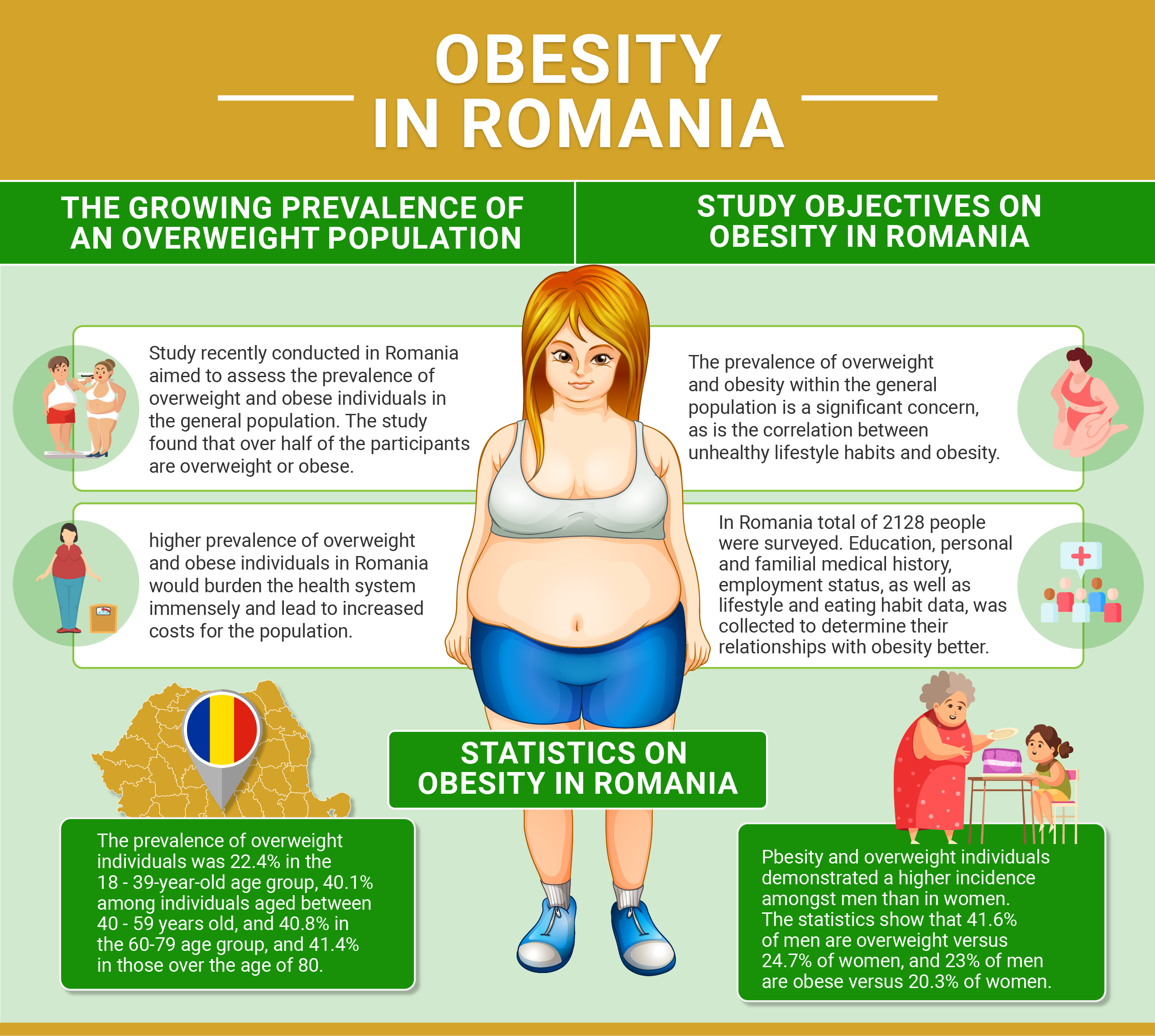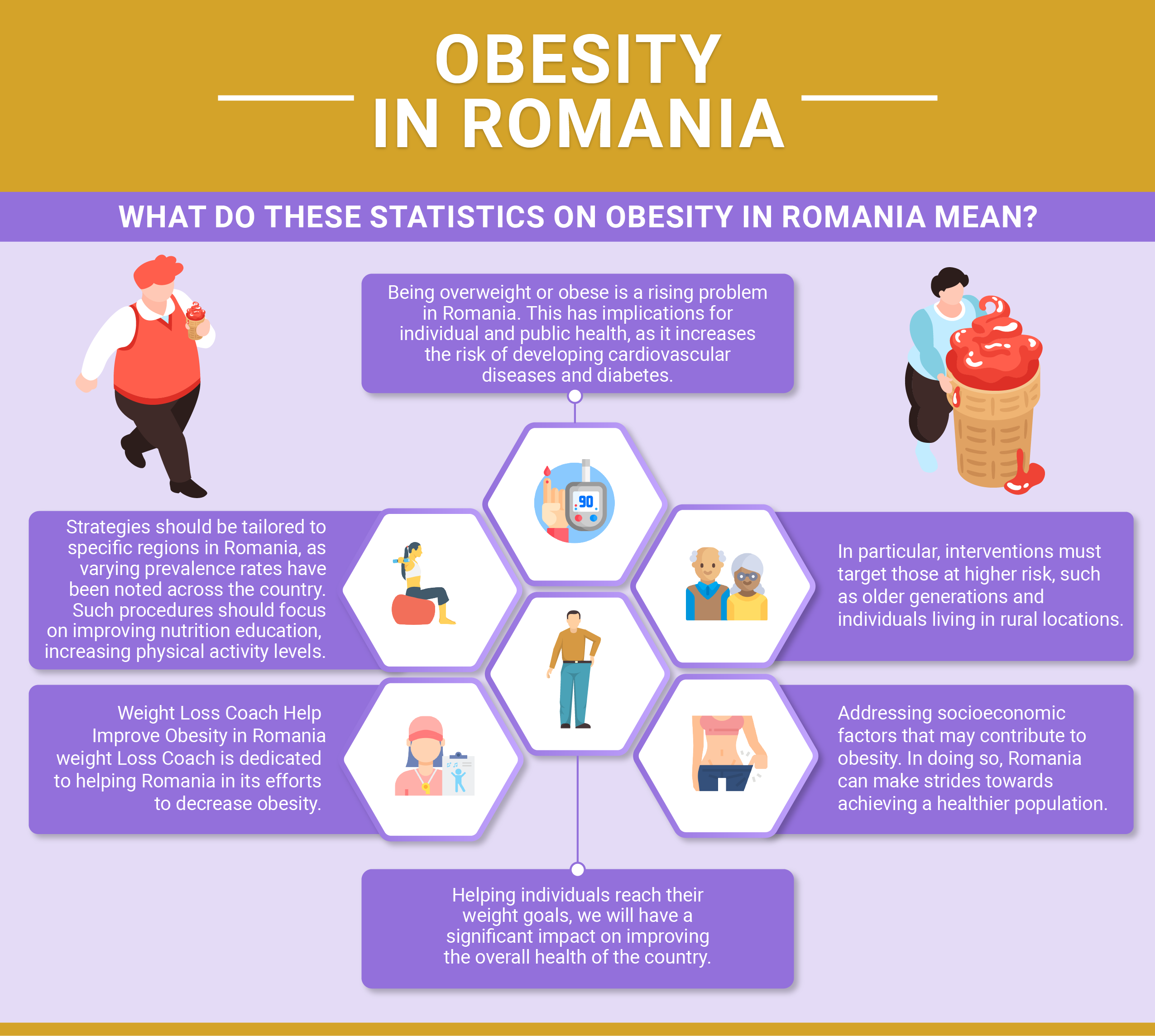
The state of being overweight or obese are global health problems that continue to plague both developing and developed countries. Despite years of research and public health campaigns, the prevalence of overweight and obese individuals is still high. In Romania, the situation is challenging to control due to a lack of data on eating behaviours and lifestyle choices. A cross-sectional study recently conducted in Romania aimed to assess the prevalence of overweight and obese individuals in the general population. The study found that over half of the participants are overweight or obese. This alarming statistic underscores the need for more research into the causes of obesity in Romania and interventions to address this growing problem.
Furthermore, obesity results in medical, financial, social, and political challenges. Higher weight numbers are directly associated with an increased risk of coronary heart disease, type 2 diabetes, stroke, and various cancers. Therefore, a higher prevalence of overweight and obese individuals in Romania would burden the health system immensely and lead to increased costs for the population. Several factors can contribute to the development of overweight or obesity, such as eating behaviours, dietary patterns, physical activity levels, location, and socioeconomic factors. As such, researchers set out to determine the prevalence of overweight and obesity in Romania and examine the associated risk factors.
The objectives and background of the study provide valuable insight into the motivations behind the study and the current obesity epidemic in Romania. The prevalence of overweight and obesity within the general population is a significant concern, as is the correlation between unhealthy lifestyle habits and obesity. Additionally, socioeconomic factors may contribute to obesity rates, and it is crucial to understand these differences between regions within Romania. This information will help to inform future interventions and policy changes needed to address the obesity epidemic in Romania.
The primary objective of the study was to assess the prevalence of overweight and obesity within the general population of Romania. As for the secondary objective, researchers aimed to identify lifestyle patterns and relationships between unhealthy lifestyle habits and obesity. In addition, researchers also sought to assess possible correlations between socioeconomic factors and obesity, as well as differences between regions within the country. This would allow researchers to understand better the factors that could contribute to an increased prevalence of overweight or obese individuals in Romania, as well as provide valuable information regarding potential interventions.
The research was a cross-sectional, epidemiologic, multi-centre, non-interventional study conducted over 8 months in Romania, including Banat, Crisana, Transylvania, Moldavia and Muntenia, and Oltenia. Researchers would collaborate with residents, physicians, and students, tasked with surveying populations in their hometowns. A total of 2128 people were surveyed during the duration of the study. Demographical, anthropometric, education, personal and familial medical history, employment status, as well as lifestyle and eating habit data, was collected to determine their relationships with obesity better.
The study found that the prevalence of overweight and obesity was significantly higher in individuals aged 60 years or older than in those younger. The prevalence of obesity was almost two times higher in the 60-79 age group than in the 18-39-year-old age group. These findings underscore the importance of prevention and intervention efforts to reduce obesity rates among older adults. To expand on this, the prevalence of overweight individuals was 22.4% in the 18 - 39-year-old age group, 40.1% among individuals aged between 40 - 59 years old, and 40.8% in the 60-79 age group, and 41.4% in those over the age of 80. As for obese individuals, the occurrence of obesity was 9.9% in the 18-39 years age group, 30.1% in the 40-59 years age group, 41.6% in the 60-79 years age group, and 24.1% in those over the age of 80.
Furthermore, obesity and overweight individuals demonstrated a higher incidence amongst men than in women. The statistics show that 41.6% of men are overweight versus 24.7% of women, and 23% of men are obese versus 20.3% of women. When comparing residential conditions, the presence of obese and overweight individuals was much higher in rural areas. Those living in urban areas displayed a 33% prevalence of overweight individuals, compared to the 30.3% of overweight individuals living in urban areas. Though marginal, this difference further reiterates the need for targeted interventions in rural areas. Moreover, the study revealed that many overweight and obese populations resided in Moldavia and Muntenia, Oltenia, as opposed to populations in Banat, Crisana, and Transylvania. This indicates the need for tailored interventions depending on region and location.
Researchers were able to accomplish their objective of assessing the prevalence of overweight and obesity in the general population of Romania. In examining the relationship between BMI and varying lifestyle factors and residential conditions, researchers determined that more than half of the study's participants enrolled were above average body weight. The study showed that 31.1% of participants were overweight, and 21.3% were obese. As such, it is increasingly important to implement strategies geared at reducing the prevalence of overweight and obesity in Romania. These strategies include increasing physical activity, improving nutrition education, and addressing socioeconomic factors that may contribute to obesity.

Being overweight or obese is a rising problem in Romania. This has implications for individual and public health, increasing the risk of developing cardiovascular diseases and diabetes. Therefore, strategies to reduce the prevalence of overweight and obesity should be implemented at an individual and community level. In particular, interventions must target those at higher risk, such as older generations and individuals living in rural locations.
Furthermore, strategies should be tailored to specific regions in Romania, as varying prevalence rates have been noted across the country. Such procedures should focus on improving nutrition education, increasing physical activity levels, and addressing socioeconomic factors that may contribute to obesity. In doing so, Romania can make strides towards achieving a healthier population.
Obesity is one of the leading causes of preventable death. That’s why it’s so important to have access to weight loss resources like Weight Loss Coach. We are here to help those in Romania lose stubborn weight and improve their lives. Our team of healthcare providers prescribes approved medications such as GLP-1 to make the weight loss process accessible to all. We complete a comprehensive analysis of our patients and can help them see results quickly.
Weight Loss Coach is dedicated to helping Romania in its efforts to decrease obesity. By helping individuals reach their weight goals, we will have a significant impact on improving the overall health of the country.

Comments